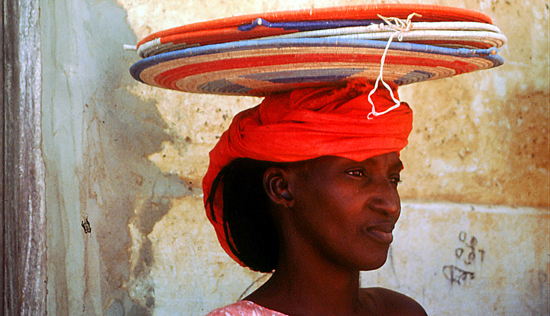Fowler Museum exhibits show art and tradition of basketry

The Fowler Museum’s newest exhibit, “Grass Roots: African Origins of American Art,” focuses on the history and importance of the art of basketry. It showcases pieces like the one shown here, featuring an African woman carrying a woven basket on her head.
By Rei Estrada
Oct. 7, 2009 11:10 p.m.
For many, a basket is just an afterthought, something incidental that you place on top of a picnic blanket and put fried chicken in. But for some South Carolina natives, baskets and basketry are a form of art and a way of life, a way to bring together communities and a rich tradition steeped in history.
“Grass Roots: African Origins of an American Art,” a new exhibit on display at the Fowler Museum, intends to enlighten viewers on the historical art form of basketry.
The exhibit, which runs from Oct. 4 to Jan. 10, showcases the history of basketry, a tradition that goes back more than 300 years but continues to be overlooked.
“Baskets are rarely a part of the corpus of works collected by African Art collectors,” said Enid Schildkrout, one of the curators of the showcase.
While “Grass Roots” includes baskets from as early as the 1700s and even some from the African mainland, the main focus is on the basketry tradition of modern South Carolina, which has been passed down from generation to generation.
“Of the many African traditions carried over to America, baskets may be one of the few that were actually carried over,” said Dale Rosengarten, a co-curator.
The baskets were a part of everyday life in Africa, used for everything from storing liquids to marriage gifts. However, it was their use in the rice-growing process that was especially useful when Africans were brought as slaves from the country’s “Rice Coast” to the then especially agricultural America.
“When they arrived in America, a whole new production system waited,” Rosengarten said.
Just like in their native Africa, the traditional bulrush workbaskets were produced and used in America for winnowing rice, the process by which rice is separated from its hull. This technology continued to be used for years, slowly adapting and changing. Sweetgrass plants, for example, began to be favored for creating baskets over the traditional bulrush.
It was around 1930 when the first basket-selling stands opened along Highway 17 in South Carolina as a way for families to increase income. The practice has grown since then, with close to 100 basket stands along the now eight-lane highway, a portion of which has been named the Sweetgrass Basket Makers’ Highway.
“Grass Roots” is accompanied by two other exhibits also concerning the basketry tradition. The first, “African American Life on the Gullah/Geechee Coast: Photographs by Greg Day, 1970-1977,” is a series of black and white photos taken in the South Carolina basketry community. Day began the project after meeting a local basket maker whose photo he took while driving through Highway 17.
“‘I know how you work that camera, you’re waiting for your mind to turn it on,’ she told me, and I was intrigued,” Day said. “I decided to become her student.”
The experience, documented in his photographs, taught Day how to be an artist.
“Fowler in Focus: African Basketry Arts, Thinking Outside the Basket,” showcases examples of basketry that go beyond the usual role as a container, with basketry working as decoration, architecture and religious item.
As the years pass, though, basketry finds itself facing opposition from a world that continues to expand and advance technologically, leaving little room for more humble traditions.
“I used to hate the art with a passion,” said Nakia Wigfall, a modern basket-maker from South Carolina.
She has since grown to appreciate the heritage, but sometimes finds it just as difficult to pass on to her own children.
“I stress to them the importance of continuing the tradition.” Wigfall said. “We’re competing with the Wii and all these other gadgets they have.”
Likewise, development projects, including deforestation of the sweetgrass marshes in the heart of the basketry community threaten the art, while the expansion of Highway 17 over the years has pushed basket sellers away from their usual stands while they simultaneously compete with noise and dust. The current state of the economy doesn’t help, either.
“Unfortunately, you can’t live on basket-making alone,” Wigfall said.
Basketry itself “is very destructible,” Rosengarten said. “It’s extremely rare to find baskets more than 100 years old.”
Still, the art has a history of perseverance, and while other technologies have sprouted up in agricultural America, the basket never went out of production.
Other efforts continue to be made to keep the tradition alive. The South Carolina-based Sweetgrass Cultural Arts Preservation Society has been running the Sweetgrass Festival annually since 2005.
“People come from all over, as far as France,” Wigfall said.
The festival celebrates the Gullah Geechee culture through handmade crafts, food and entertainment, as well as the sweetgrass basketry tradition.
Likewise, Wigfall and others run workshops and demonstrations where they continue to pass on the traditions.
Efforts are being made to transplant sweetgrass plants into areas closer to the basket makers and less disturbed by construction.
“We won’t allow this art to die,” Wigfall said,
Rosengarten feels the same way, seeing promise and hope for the future in the growing basketry movements.
“There’s a new freedom … that no one could have predicted,” she said, “I hope this elevation to art inspires the next generation and keeps them sewing.”


